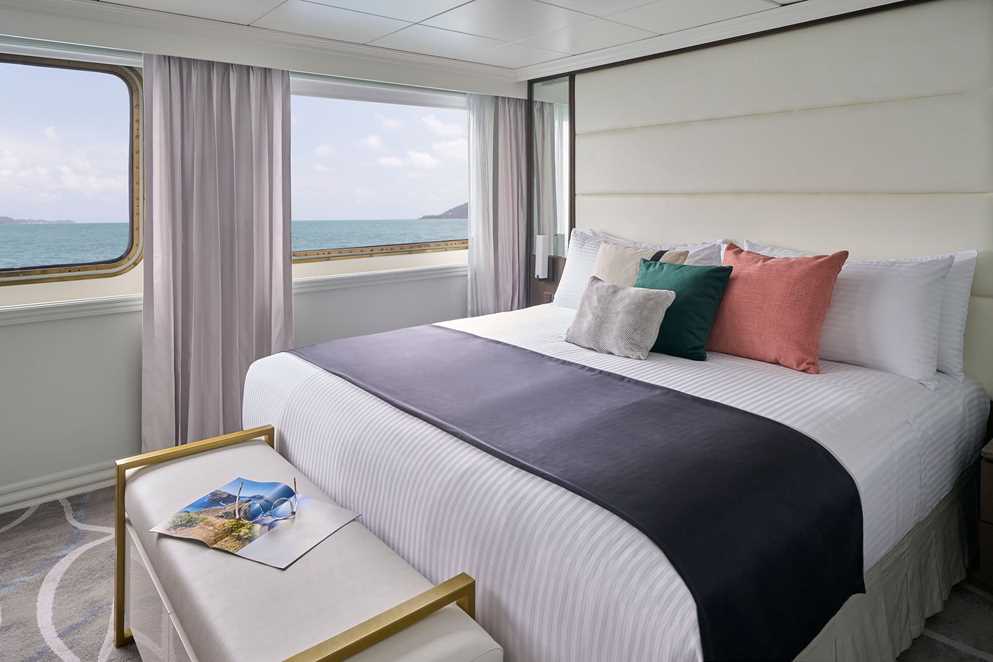
A guest takes a photo with their iPhone of a Giant Tortoise in the highlands of Santa Cruz Island, Galapagos Islands National Park, Ecuador. Photograph: Ralph Lee Hopkin
Exact dates to be confirmed by Summer 2025. More information to come.
Please note that details regarding this tour are still being developed, but do not let that dissuade you from reserving your spot to witness this incredible phenomenon. Guarantee your spot by reserving today!

Lindblad Expeditions newest ship, National Geographic Islander II, is a gracious expedition vessel that feels like a private yacht. With only 26 staterooms and suites, and accommodating just 48 guests, she sails with a 1:1 guest-to-crew ratio.
Special features include teak decks, indoor-outdoor dining options, an impressive observation deck, and new amenities like a climate-controlled marina and a dedicated science hub.
Spacious accommodations include 18 staterooms, 4 solo staterooms, and 4 Islander Suites accommodating just 48 guests—all with large windows, convertible king/twin beds with 600-thread count bedding, ample closets, sofa, and marble double-sink bathrooms with a rain shower featuring a collection of organic amenities crafted exclusively for Lindblad Expeditions. In addition, a stocked mini-bar can be customized to guests’ preferences, and there’s in-room coffee and tea, Wi-Fi, and a flat-screen TV.

Standard Outside

Suites


Exact dates to be confirmed by Summer 2025

This morning we will observe the annular (ring) eclipse of the Sun from either on shore at an island close to the predicted centerline of the eclipse path or from the ship. The map shows the locations of the various Galapagos islands and the center of the eclipse path (blue line) as well as the northern edge of the eclipse path (red line). North/above the red line the eclipse is purely a deep partial eclipse. Below the red line the eclipse becomes more annular (ring-like) as you move toward the blue line. We will provide ‘eclipse glasses’ for safe viewing. Anyone attempting to photograph the eclipse should be able to do so regardless of whether we are on shore or at sea since the exposure times will be short. A neutral density #5 filter will be required for photography in front on the lens of any camera. It would be good to practice using this on any day when you can see the Sun in order to get an idea of the proper exposure time required and the preferred ISO value you want to use. Even if the we are on ship and it is rocking, the exposure times will be short enough that there should be no blurring of the Sun’s image. The photo below is an accurate example of what the ring eclipse will look like if we are near the centerline. Should sea or sky conditions preclude being at the center all the area in the photo map showing the eclipse path between the blue and red lines gives plenty of other locations to which we can maneuver the ship.
Local time in the Galapagos is GMT-6 hours (the same as Central Standard Time in the USA). The eclipse begins at sunrise (6:07am) and ends 2 hours 51 minutes later. At the start the Sun’s elevation and azimuth are 0 and 108 degrees, respectively. At mid eclipse the elevation and azimuth increase to 17 and 109 degrees, while at the end of the eclipse (8:58am) the elevation and azimuth are 39 and 113 degrees. From the centerline the duration of annularity (the length of time the Moon remains within the interior diameter of the Sun) is 7minutes 46seconds. However, this time is reduced the farther north one travels. For example, at Isla Espanola the duration of annularity becomes 7 minutes 13 seconds, while from the airport where we fly into from the mainland ( on Isla Santa Cruz ) the duration shrinks to 3 minutes 48 seconds. We will be constantly monitoring the weather to get into the best position for the maximum eclipse. The highest percentage of the Sun covered should be around 83 percent; the distance from the centerline to the north edge is 109 miles/175km

Exact dates to be confirmed by Summer 2025
PRICE
Standard Double Outside cabin: $13,998*
Standard Single Outside cabin: $16,998*
Suites: $17,998*
*EARLY BOOKING PRICING IS PER PERSON AND IS AVAILABLE UNTIL NOVEMBER 30, 2024.
AFTER THAT DATE PRICE INCREASES BY US$1,000 PER PERSON.
Due to the limited availability of solo cabins, we can only accept 3 single occupancies on this trip.
Triple or Quad occupancy is not available.
PAYMENT SCHEDULE (per person)
Non-refundable deposit of US$1,800 is due at time of booking.
2nd nonrefundable deposit of US$5,000 is due by September 30, 2026.
If booking after September 30, 2026, then a non-refundable deposit of US$6,800 is due at time of booking.
Final Payment is due by April 30, 2027.
CANCELLATION FEES (per person)
Cancellation fees are based on the date the written notice is received by Direct Travel (notifications of cancellation must be received in writing). A full copy of our terms can be found in the booking form.
Before September 30, 2026 – US$1,800 deposit is non-refundable.
October 1, 2026 – April 30, 2027 – US$6,800 is non-refundable.
After April 30, 2027 – Full Penalty, no refund
TRAVEL PROTECTION PLAN
We highly recommend the purchase of trip cancellation and delay insurance (cancel for any reason is recommended). Our experts at Direct Travel will help you identify the best plan for you by providing a quote and assisting you with purchasing the insurance.
HOW TO SIGN UP FOR THE EXPEDITION
